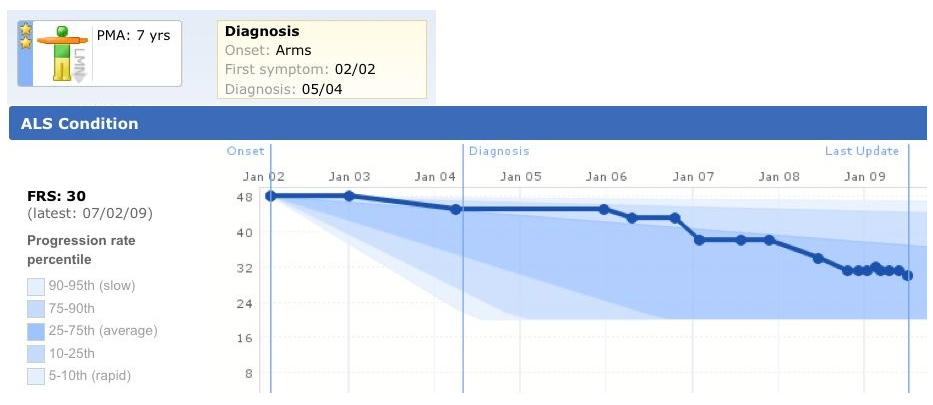Primary Lateral Sclerosis (PLS) and Progressive Muscular Atrophy (PMA) are two rare variants of the disease ALS. Normally, ALS affects the upper motor neurons in the brain and spinal cord, as well as the lower motor neurons that send signals from the spinal cord directly to muscles. PLS and PMA are different because PLS only affects the upper motor neurons, and PMA only affects the lower motor neurons. It's an important distinction for patients to be told about because the prognosis is less severe in these conditions. On average, survival in ALS is typically reported to be 2-5 years, whereas for patients with PMA it's more like 5-10 years and for PLS it's even longer (often several decades).
ALS itself is a rare condition, affecting some 30,000 people in the United States at any one time. PLS and PMA each represent approximately 5% of the overall ALS community, so there's approximately 1,500 patients with each condition in the U.S at any given time. In April 2008, PatientsLikeMe added the ability for members of our ALS community to change their diagnosis to these rare conditions. To date, we now have 182 patients with PLS and 270 with PMA. This is truly exciting because even the largest studies in the literature have only examined 40 or so PLS patients and a similar number of PMA patients. One of our most useful features on our site for people with ALS is the percentile curves, which we display as a backdrop on their profiles to put each individual's rate of progression into context. However, as you can see in the figure below, when you compare the progression curves of ALS patients on our site with those of a typical PLS patient, the PLS patient progression deviates significantly from the ALS curves.

With so many PLS and PMA patients sharing such valuable information about their disease on PatientsLikeMe, we had enough information to generate a new set of percentile curves for each of those communities. To do this, we used self-report ALSFRS-R (ALS functional rating score - revised) data from 104 PLS patients and 59 PMA patients that met our criteria for data quality. We have good data for the first 4-5 years of disease after onset, and after that point we rely on linear extrapolation to make the plots. Here we see the value of openness in action. When you see the potential value in contributing your data, it drives a virtuous cycle: the more data you enter, the more value you get, so you enter more data!

As any of our patients in these communities will tell you, being diagnosed with a rare disease can be a frustrating experience. Aside from dealing with the condition itself, there's the lack of public awareness, a lack of research investigating your condition, and a sense that you are being "lumped in" with a similar disease because your community doesn't have the critical mass to merit its own attention. These new percentile curves for PLS and PMA patients demonstrate the value and power of openness. By sharing their health data in an open fashion, patients are providing new insights that are changing how we think and act when it comes to these very rare conditions.
Note: A potential limitation of these curves is that they represent the outcomes for patients that are members of PatientsLikeMe and may not be generalizable to the entire population; we are working hard to better understand and correct for the biases in our population and data. As the size and longevity of each community increases, we will be in a better position to address these issues.
